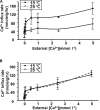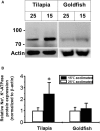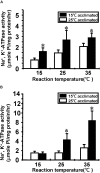Comparison of Calcium Balancing Strategies During Hypothermic Acclimation of Tilapia (Oreochromis mossambicus) and Goldfish (Carassius auratus)
- PMID: 30233401
- PMCID: PMC6129941
- DOI: 10.3389/fphys.2018.01224
Comparison of Calcium Balancing Strategies During Hypothermic Acclimation of Tilapia (Oreochromis mossambicus) and Goldfish (Carassius auratus)
Abstract
The body temperatures of teleost species fluctuate following changes in the aquatic environment. As such, decreased water temperature lowers the rates of biochemical reactions and affects many physiological processes, including active transport-dependent ion absorption. Previous studies have focused on the impacts of low temperature on the plasma ion concentrations or membrane transporters in fishes. However, very few in vivo or organism-level studies have been performed to more thoroughly elucidate the process of acclimation to low temperatures. In the present study, we compared the strategies for cold acclimation between stenothermic tilapia and eurythermic goldfish. Whole-body calcium content was more prominently diminished in tilapia than in goldfish after long-term cold exposure. This difference can be attributed to alterations in the transportation parameters for Ca2+ influx, i.e., maximum velocity (Vmax ) and binding affinity (1/Km ). There was also a significant difference in the regulation of Ca2+ efflux between the two fishes. Transcript levels for Ca2+ related transporters, including the Na+/Ca2+ exchanger and epithelial Ca2+ channel, were similarly regulated in both fishes. However, upregulation of plasma membrane Ca2+ATPase expression was more pronounced in goldfish than in tilapia. In addition, enhanced Na+/K+-ATPase abundance, which provides the major driving force for ion absorption, was only detected in tilapia, while upregulated Na+/K+-ATPase activity was only detected in goldfish. Based on the results of the present study, we have found that goldfish and tilapia differentially regulate gill epithelial plasma membrane Ca2+-ATPase (PMCA) expression and Na+/K+-ATPase activity in response to cold environments. These regulatory differences are potentially linked to more effective regulation of Ca2+ influx kinetics and better maintenance of whole body calcium content in goldfish than in tilapia.
Keywords: Ca2+ influx; Ca2+-ATPase; cold acclimation; gill; teleost.
Figures






Similar articles
-
Environmental and cortisol-mediated control of Ca(2+) uptake in tilapia (Oreochromis mossambicus).J Comp Physiol B. 2016 Apr;186(3):323-32. doi: 10.1007/s00360-016-0963-7. Epub 2016 Feb 8. J Comp Physiol B. 2016. PMID: 26857273 Free PMC article.
-
The effect of water acidification on prolactin cells and pars intermedia PAS-positive cells in the teleost fish Oreochromis (formerly Sarotherodon) mossambicus and Carassius auratus.Cell Tissue Res. 1984;238(3):601-9. doi: 10.1007/BF00219878. Cell Tissue Res. 1984. PMID: 6525622
-
Altered activities of branchial and renal Na/K- and Mg-ATPases in cold-acclimated goldfish (Carassius auratus).Comp Biochem Physiol B. 1983;74(3):503-6. doi: 10.1016/0305-0491(83)90218-3. Comp Biochem Physiol B. 1983. PMID: 6132750
-
The interactive effect of digesting a meal and thermal acclimation on maximal enzyme activities in the gill, kidney, and intestine of goldfish (Carassius auratus).J Comp Physiol B. 2017 Oct;187(7):959-972. doi: 10.1007/s00360-017-1068-7. Epub 2017 Apr 5. J Comp Physiol B. 2017. PMID: 28382530
-
Gene expression of growth hormone family and glucocorticoid receptors, osmosensors, and ion transporters in the gill during seawater acclimation of Mozambique tilapia, Oreochromis mossambicus.J Exp Zool A Ecol Genet Physiol. 2010 Aug 1;313(7):432-41. doi: 10.1002/jez.613. J Exp Zool A Ecol Genet Physiol. 2010. PMID: 20623800
References
-
- Aho E., Vornanen M. (1998). Ca2+-ATPase activity and Ca2+ uptake by sarcoplasmic reticulum in fish heart: effects of thermal acclimation. J. Exp. Biol. 201 525–532. - PubMed
-
- Allanson B. R., Bok A., Van Wyk N. I. (1971). The influence of exposure to low temperature on Tilapia mossambicus Peters (Cichlidae). II. Changes in plasma osmolarity, sodium and chloride ion concentrations. J. Fish Biol. 3 181–185. 10.1111/j.1095-8649.1971.tb03661.x - DOI
LinkOut - more resources
Full Text Sources
Other Literature Sources
Research Materials
Miscellaneous

